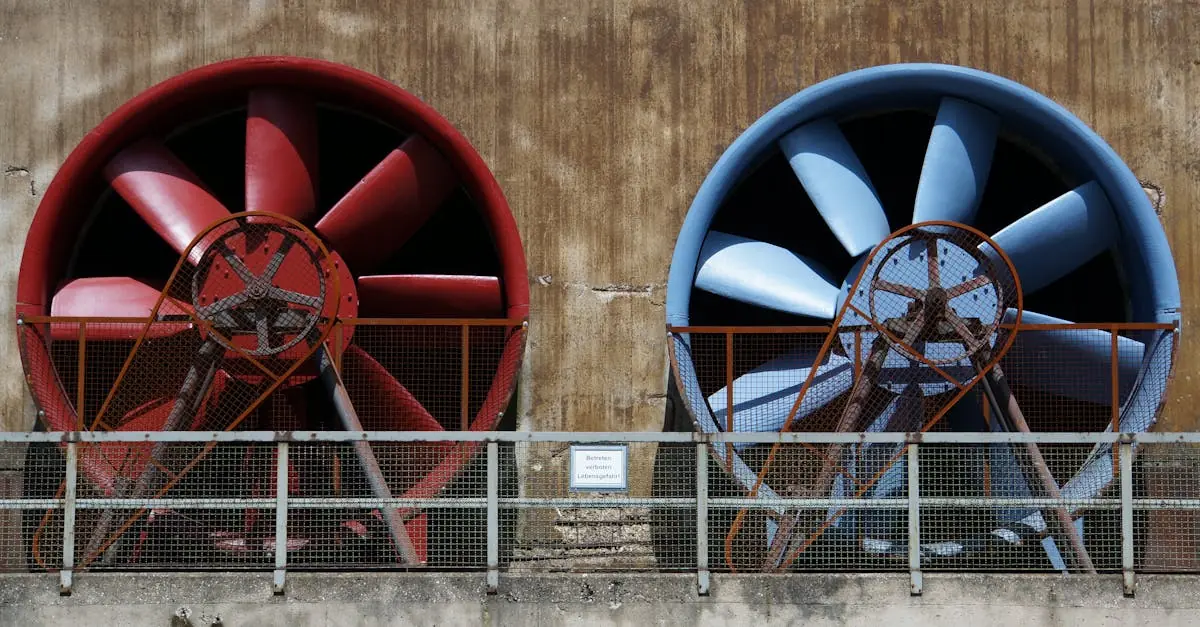Keeping your ventilation system in tip-top shape isn’t just a chore—it’s a necessity for a healthy home. Imagine your air ducts throwing a party, inviting dust bunnies and allergens to crash. Not exactly the vibe you want, right? A solid ventilation maintenance checklist can save the day, ensuring your indoor air stays fresh and breathable.
Table of Contents
ToggleImportance Of Ventilation Maintenance
Maintaining ventilation systems ensures indoor air quality remains at acceptable levels. A well-maintained system prevents the buildup of dust and allergens, which can trigger respiratory issues. Regular maintenance also enhances energy efficiency, leading to lower utility bills. Neglecting ventilation can lead to mold growth, a significant health risk for occupants.
Air circulation plays a critical role in reducing humidity levels, preventing dampness, which creates a hospitable environment for pests. Duct cleaning keeps systems operating efficiently, prolonging the life of HVAC equipment. Homeowners experience fewer breakdowns and repairs when they prioritize maintenance.
Safety stands as another concern. Blocked vents can cause dangerous gases like carbon monoxide to accumulate indoors. Regular inspection and maintenance can detect potential issues before they escalate into serious hazards.
Seasonal checkups are essential. They allow homeowners to address any operational inefficiencies associated with temperature extremes. A professional inspection can ensure filters are clean and replaced as necessary, which directly impacts airflow quality.
Neglecting maintenance costs more in the long run. Repairing damage from poor air quality or equipment failure can exceed the cost of regular upkeep. Comprehensive ventilation maintenance checklists help homeowners remain proactive, ensuring all elements of the system receive attention.
Key Components Of A Ventilation Maintenance Checklist
A comprehensive ventilation maintenance checklist focuses on essential tasks to ensure optimal system performance. Keeping up with these tasks enhances indoor air quality and system efficiency.
Inspecting Ventilation Systems
Inspecting ventilation systems regularly identifies potential issues early. Technicians look for signs of wear or damage in ducts and components. A thorough examination should include checking for improper sealing and examining joints for leaks. Inspecting the insulation also plays a crucial role in maintaining system efficiency. Visual inspections combined with measurements can ensure the entire ventilation system operates correctly.
Cleaning Filters and Ducts
Cleaning filters and ducts is vital for sustaining good airflow. Clogged filters can restrict air movement, making the system work harder. They should be replaced or washed every one to three months, depending on usage. Duct cleaning should occur every three to five years to eliminate debris and allergens that accumulate over time. Removing dust, dirt, and mold significantly improves indoor air quality and system functionality.
Checking Airflow and Pressure
Checking airflow and pressure ensures systems perform efficiently. Measuring airflow at vents and registers determines if there’s adequate distribution throughout the space. Pressure readings should fall within the manufacturer’s specified range for optimal performance. Identifying imbalances may require adjustments to the duct system or fan speeds, which can improve comfort and reduce energy costs. Frequent monitoring helps maintain ideal conditions within the home.
Common Maintenance Issues
Homeowners often encounter various maintenance issues that can affect ventilation systems. Addressing these problems ensures optimal indoor air quality and system performance.
Clogged Filters
Clogged filters reduce airflow, making systems work harder. Filters require regular checks every one to three months. Homeowners should replace or clean filters based on their condition. Inadequate airflow can lead to increased energy consumption and higher utility bills. Allergens and dust accumulation also contribute to respiratory problems. Regular filter maintenance promotes better air quality and extends the lifespan of HVAC equipment.
Duct Leaks
Duct leaks significantly impact energy efficiency. Leaky ducts can cause up to 30% of a system’s heating and cooling energy to be lost. Early identification of leaks is crucial. Homeowners should check for visible gaps or listen for whistling sounds. Sealing leaks with appropriate materials improves airflow and reduces strain on the HVAC system. Preventing such issues not only saves money but also enhances overall comfort in the home. Regular inspections help maintain duct integrity and efficiency.
Best Practices For Effective Maintenance
Effective ventilation maintenance requires a structured approach to keep systems running smoothly. Following best practices ensures healthy indoor air quality and system longevity.
Regular Scheduling
Establishing a regular scheduling routine for maintenance tasks significantly improves ventilation efficiency. Scheduling seasonal checkups allows technicians to address potential issues before they escalate. Homeowners benefit from having a specific timeframe, creating a disciplined maintenance approach. Setting reminders for filter replacement ensures good airflow, as filters should be cleaned or replaced every one to three months. Duct cleaning, on the other hand, requires attention every three to five years, depending on usage and environment. Consistent scheduling minimizes the risk of unexpected failures and associated costs.
Documentation and Record Keeping
Maintaining detailed documentation and record keeping reinforces effective ventilation practices. Logging maintenance activities, including filter changes and inspections, creates a comprehensive history of system care. Homeowners can identify patterns in service needs by tracking performance over time. Documentation facilitates the early detection of recurring issues, enabling timely interventions. Keeping detailed records simplifies communication with service professionals, ensuring they have complete insight into system history. A well-maintained log can enhance the resale value of a property, demonstrating responsible care to prospective buyers.
Maintaining a ventilation system is vital for ensuring a healthy living environment. By following a structured maintenance checklist, homeowners can prevent issues like poor air quality and increased energy costs. Regular inspections and timely cleaning of filters and ducts not only improve airflow but also extend the lifespan of HVAC equipment.
Proactive maintenance reduces the risk of mold growth and pest infestations, creating a safer home. Setting reminders for routine tasks and keeping detailed records can enhance efficiency and even boost property value. Prioritizing ventilation maintenance is a smart investment in both comfort and health.








